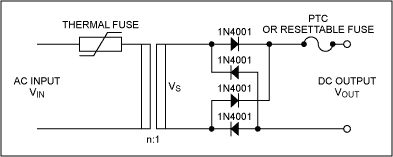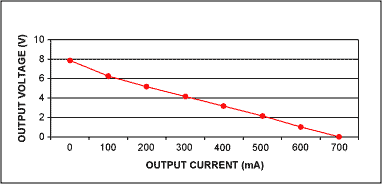
IntroducTIonMany handheld devices are using a single-cell Li+ battery, and they demand a simple and economic charging soluTIon. A cradle charger is one choice and it is getTIng more attention from system design engineers because they do not need to worry about built-in charging logic in their handheld devices. The cradle charger provides a complete standalone Li+ charger solution.
This application note describes an inductorless and virtually lossless single-cell Li+ cradle charger using a low-cost linear adapter.
Linear Input Power Supply for the Cradle Charger

Figure 1. Off-line cradle charger block diagram.
As shown in Figure 2, this simple linear AC adapter does not have a voltage and current regulation circuit, but if the AC input voltage variation and the output impedance of the AC linear transformer adapter are known its output characteristics can be predicted.

Figure 2. AC linear transformer adapter block diagram.
Figure 3 shows the equivalent circuit diagram of the Figure 2 linear transformer. Zout is the output impedance of the AC linear adapter.

Figure 3. Equivalent circuit diagram of the linear transformer adapter.
We can design a transformer that has a turn ratio n.
n= Np/Ns= Vin/Vs
If Vin=120Vac and Vs=12Vac, then n is 10. If the Vin's variation is ±10%, the Vs will vary ±10% as well.
The output voltage of the Figure 2 adapter at Rload:
Vout = (1/n) × Vin × Rload/ (Zout + Rload)
For example, if Vout1 = 9V at 1mA and Vout2 = 4.5V at 500mA load under the nominal AC input, the output impedance of the AC linear transformer adapter should be
Zout = (Vout1 - Vout2)/(500mA - 1mA)
= (9 - 4.5)/ 0.499
= 9Ω
Figure 4 shows the output voltage and current characteristics of an example linear adapter, rated input = 120VAC 60Hz and output = 3.7V at 350mA, that was designed as in Figure 2.

Figure 4. Output characteristics of a 3.7V at 300mA linear adapter.
Table 1. Output Load vs. Output Voltage
欢迎分享,转载请注明来源:内存溢出
赞
(0)
打赏
 微信扫一扫
微信扫一扫
 支付宝扫一扫
支付宝扫一扫
 微信扫一扫
微信扫一扫
 支付宝扫一扫
支付宝扫一扫
关于ClearNAND闪存的系统详解
上一篇
2022-08-04
仿真看世界之IPOSIM的散热器热阻Rthha解析
下一篇
2022-08-04

评论列表(0条)